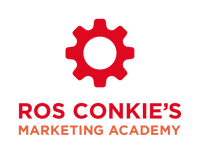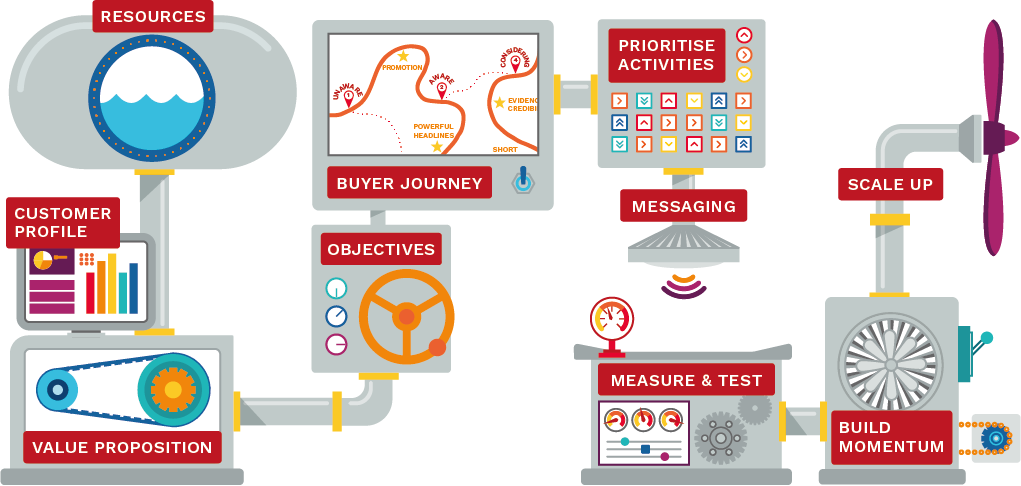I used to think marketing was fluff. A “dark art”. Creative nonsense with no structure or logic behind it.
In fact, I believed this so strongly that, as a young Design Engineer, when my boss said “Ros I think you’d be good in marketing”, I wanted to say “no I don’t think so”.
As I started working in sales and marketing I began to realise that, yes, bad marketing is fluff. We’ve all seen it! But good marketing is structured and methodical. It’s based on solid research. It’s carefully planned, designed, executed and project managed. Good marketing has a lot in common with engineering, it turns out.
Here’s how you can apply an engineering design process to create a marketing machine that’ll power your business growth.
In fact, I believed this so strongly that, as a young Design Engineer, when my boss said “Ros I think you’d be good in marketing”, I wanted to say “no I don’t think so”.
As I started working in sales and marketing I began to realise that, yes, bad marketing is fluff. We’ve all seen it! But good marketing is structured and methodical. It’s based on solid research. It’s carefully planned, designed, executed and project managed. Good marketing has a lot in common with engineering, it turns out.
Here’s how you can apply an engineering design process to create a marketing machine that’ll power your business growth.
1. Define the problem and set constraints
When designing a product, machine, software or anything else, the first thing to do is define the problem or need, and set constraints.
The problem that marketing solves is not simply “generating leads”. It’s much bigger than that. The purpose of marketing is to generate happy, loyal customers. Marketing is basically a ‘happy customer’ machine. So how do you generate happy, loyal customers? You need to make it as easy and comfortable as possible for buyers to choose you. Read my blog “What’s the point of marketing?” for more about this.
With that in mind, we next need to set constraints: what resources do we have? What’s our marketing budget? What timescales do we want to achieve our goals by?
The problem that marketing solves is not simply “generating leads”. It’s much bigger than that. The purpose of marketing is to generate happy, loyal customers. Marketing is basically a ‘happy customer’ machine. So how do you generate happy, loyal customers? You need to make it as easy and comfortable as possible for buyers to choose you. Read my blog “What’s the point of marketing?” for more about this.
With that in mind, we next need to set constraints: what resources do we have? What’s our marketing budget? What timescales do we want to achieve our goals by?
2. Define your audience and proposition
Your product (and your marketing machine) is going to be used by someone so you need to know everything you can about them.
Then you need to make sure you are describing your offering in a way that answers that all-important question “how does this deliver what I value?”
Your audience and proposition have to match up because we all value different things depending on our circumstances and roles.
Then you need to make sure you are describing your offering in a way that answers that all-important question “how does this deliver what I value?”
Your audience and proposition have to match up because we all value different things depending on our circumstances and roles.
3. Create a specification
Set specific marketing objectives making sure you will know when you’ve achieved them. This blog explains why you need objectives and how to set them.
4. Design your marketing machine
Map out your customer’s buying journey so you can see exactly how they will go from never having heard of you to buying from you. What does that look like? Are there any big leaps of faith your customer has to take where you can add a stepping stone to make it less risky? What other marketing activities can you add to make the journey easier and more comfortable for your buyers?
Once you’ve created your marketing “wish list” you then need to prioritise. I use a matrix method I learned at university, which is used to objectively prioritise which features should be included in a product. There are lots of methods but the most important thing about prioritisation is not the method itself, its whether you trust it. If you trust the method then it fulfils its purpose: to take away that stress and doubt and stop you wasting time debating what you should be doing first.
Once you’ve created your marketing “wish list” you then need to prioritise. I use a matrix method I learned at university, which is used to objectively prioritise which features should be included in a product. There are lots of methods but the most important thing about prioritisation is not the method itself, its whether you trust it. If you trust the method then it fulfils its purpose: to take away that stress and doubt and stop you wasting time debating what you should be doing first.
5. Model and prototype your marketing machine
Before you do any marketing activity, set an objective for the activity in the same way you’d set a specification for each component of a machine. Work out how much the activity will cost and what you need to generate in measureable outcomes to get a return on your investment. Here’s a blog I wrote on the subject: Will this marketing activity work?
6. Test and measure… and incrementally improve
With any new marketing activity it’s best to test the water first before investing heavily in it. But there’s only value in testing if you also measure the results and can link that back to your objective. You need to be able to answer the question, “Did it work?"
7. Scale up
When your marketing machine is purring along efficiently, generating lots of happy, loyal customers, that’s when you can scale it up by either ramping up the activities that you know work or by adding more traffic sources.
Engineering Your Marketing Machine
I still find it quite funny that I’ve ended up coming full circle in my career. Now I use tools and methods I learned in my degree to create marketing processes that work efficiently and effectively.
I take every single client through this process because it works. If you're interested in taking your business through this transformative process, book a call with me and we'll talk.
I take every single client through this process because it works. If you're interested in taking your business through this transformative process, book a call with me and we'll talk.


Comments